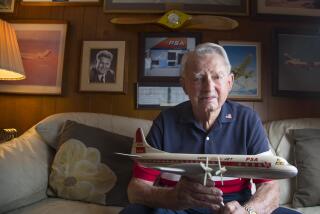Countywide : Veterans Recall P-38, War Days
- Share via
There’s never been an airplane quite like the P-38 Lightning.
Just ask Huntington Harbour resident Richard E. Willsie, who made a narrow escape from German soldiers in one of the twin-engine, twin-fuselage planes in one of the remarkable exploits of World War II.
Willsie, 71, will be on hand Friday when a bronze replica of one of the war’s most versatile fighter planes is unveiled Friday at the U.S. Air Force Academy in Colorado Springs, Colo. Willsie, who is retired from the Air Force after 32 years of service, is president of the P-38 National Assn., whose members raised $95,000 to pay for the P-38 memorial.
Willsie was a 23-year-old captain leading his squadron of P-38s on a divebombing raid on the Ploesti oil fields in Romania in 1944 when enemy gunfire knocked out one of his engines and damaged the other.
“I’m going down,” he told his companion over the radio.
“Pick a good spot,” his wing answered, “and I’ll come down and get you.”
While other Lightnings strafed German soldiers who were closing in, flight officer Richard Andrews pulled his P-38 alongside the grounded flier in a pasture after Willsie set off a diversionary bomb to hide his location from the Germans.
Willsie threw himself onto Andrews’ lap in the tiny cockpit that was designed for one person. Eventually, the two made it safely to Russia.
The cockpit was so small that the two men had to struggle to squeeze into it when reporters asked them to re-enact the escape, Willsie’s wife, Marilyn, said.
As a result of the rescue, Andrews, who was too young to be a commissioned officer at the time, was given a Silver Star for gallantry.
The two men will be reunited this week at ceremonies that also will feature a flyover of four P-38s.
Gen. William Lyon of Coto de Caza, who keeps his P-38 hangared at John Wayne Airport, will also be present.
There are only seven of the nearly 10,000 Lightnings manufactured by Lockheed still in flying condition, according to Jack Mullan of Newport Beach, who once flew P-38 photoreconnaissance missions into Formosa and Okinawa and other enemy-held territories.
The P-38 was the only aircraft to fight successfully in all theaters of operation in World War II, Mullan said.
The two leading all-time American aces flew P-38s. Richard Bong shot down 40 enemy planes and Tom McGuire had 38, according to Mullan, 67.
And, it was a P-38 that ambushed and shot down a plane carrying Japanese Adm. Isoroku Yamamoto, who planned the attack on Pearl Harbor.
The P-38 could travel about 500 miles an hour--faster in a dive. It was one of the most maneuverable of warplanes, Mullan said.
Its firepower of four 50-caliber machine guns and one 20-millimeter cannon, all concentrated in the aircraft’s nose, “could tear apart a panzer column (tanks) as well as a Mitsubishi or Messerschmitt,” according to John Stanaway, a P-38 association historian. The first P-38 was built in 1939 and production ceased on V-J Day in 1945.
Frank Hurlbut, 70, of Newport Beach, remembers the plane with fondness.
“I had an engine shot out on my third mission,” said Hurlbut, who downed eight German planes and one Italian plane in dogfights over Africa to become an official ace.
However, since the aircraft had two engines instead of one, he was able to make it back to his base.
“If it didn’t have two engines, I’d still be out there swimming in the Mediterranean trying to get back,” he said.
More to Read
Sign up for Essential California
The most important California stories and recommendations in your inbox every morning.
You may occasionally receive promotional content from the Los Angeles Times.













